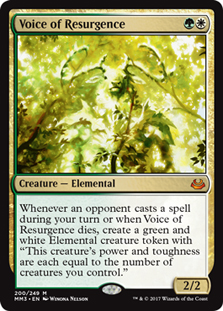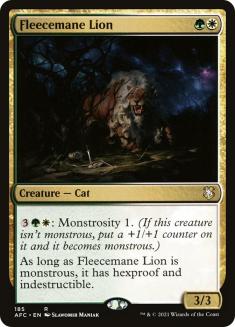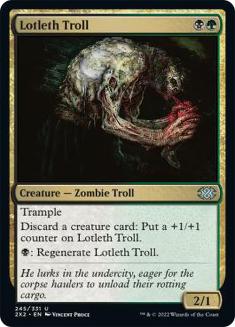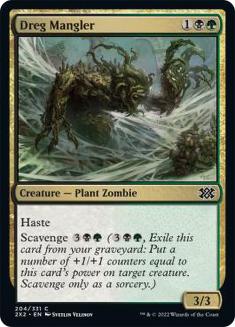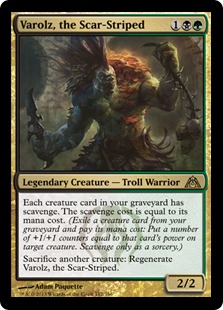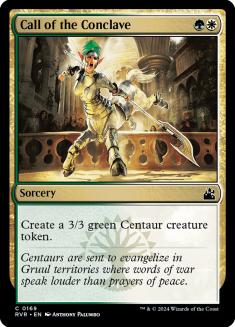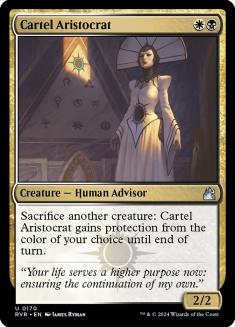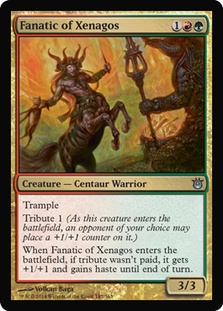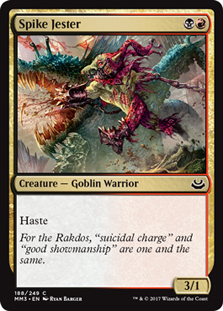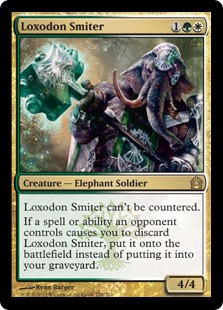Let’s get this out of the way first—Mana Confluence is the single most important card in Journey into Nyx.
There is nothing that defines a format nearly as much as the mana producing cards available. In the Standard format prior to the release of Theros, we saw a plethora of successful three-color decks, like The Aristocrats (of the Act II and Junk varieties), Jund, Naya Blitz, and U/W/R Flash, and even the occasional four-color deck, like Bant splashing for Kessig Wolf Run or Nephalia Drownyard.
In the current Standard format, we still have multicolor decks such as Esper Control and Jund Monsters, but there has been a strong trend toward fewer colors, whether fully monocolor or with a light splash. This trend is even more pronounced among aggressive decks, in part due to the power of Mutavault and in part due to how bad the mana is for anyone trying to play multicolored cards on curve.
Right now Standard is pretty much broken up into Mutavault decks and Temple decks, with top dog Mono-Black Devotion in the envious position of one that can effectively run both without messing up its colored mana or its mana curve. Because of the power of Mutavault and the lack of a second dual land that enters the battlefield untapped, we have not seen true two-colored aggressive decks performing well in the current Standard format. Occasionally a G/W Aggro decks puts up a good showing, but never consistently—a fact that is due in some part to Lifebane Zombie but also to the lack of Sunpetal Grove.
I remember when I was testing for Pro Tour Theros back when the set was first released. To the surprise of absolutely no one, I was working on an aggressive G/R deck featuring Domri Rade. The deck had Experiment One, Elvish Mystic, Burning-Tree Emissary, Kalonian Tusker, and Reverent Hunter alongside Ghor-Clan Rampager to punch through larger creatures.
The more I played with the deck, the more I grew to hate Temple of Abandon. My deck was designed to curve out and hit my drops from turn 1 onward, and that just wasn’t possible with even one land that entered the battlefield tapped in the mix. I had the same experience again with the G/B Aggro deck I was working on in the months just after the Pro Tour, though in that case I was forced to stoop so low as to play Guildgates and my mana was still bad and clunky.
Mana Confluence changes all that. Not only does it offer much needed mana fixing for aggressive two-color decks, but it may even once again make aggressive three-color decks a reality once again. I for one am looking forward to being able to actually play many of the cool gold cards from Ravnica block (and some new ones from Theros) that have been largely relegated to the sidelines due to their casting cost not quite agreeing with the mana available in the format.
To say nothing of double colored casting cost creatures in two-color decks, like Banisher Priest and Boon Satyr.
Mana Confluence is certainly not without its costs though. Taking damage every time you tap a land for mana definitely adds up. I certainly wouldn’t just go putting a playset of it into any deck with shaky mana and call it a day. It’s a card that I can definitely see playing as a one- or two-of in multicolor midrange decks that want a little extra consistency, but I’d only play four of them if I was really looking to end the game fast.
Then again, I have a history of being something of a maniac.
Creatures (25)
- 4 Llanowar Elves
- 4 Birds of Paradise
- 4 River Boa
- 4 Blastoderm
- 4 Ancient Hydra
- 2 Rith, the Awakener
- 3 Jade Leech
Lands (24)
Spells (11)
Sideboard

So maybe I have something of a soft spot for City of Brass and its ilk since I made my first Pro Tour Top 8 on the back of four copies in a format where virtually every deck had four copies of Rishadan Port. In most situations Mana Confluence is identical to City of Brass, but the loss of life coming as part of the mana ability rather than a tap trigger is a big deal in a world where everyone is tapping your lands and certainly doesn’t have very good synergy with the tapout effect of Chimeric Idol. Thankfully, I had four copies of Armageddon to wipe every land from the board, including my own painful City of Brass.
The tournament in which I played this deck was dominated by two different major decks: G/R decks built around Fires of Yavimaya and Saproling Burst and Rebel decks. My deck was particularly strong against both of them because they were very mana hungry and I had the full set of Armageddon along with Wax // Wane, which served as both an excellent combat trick and efficient removal for Fires, Burst, or Parallax Wave. I wanted a little bit of extra insurance from my sideboard, though, so I played four copies of Armadillo Cloak against Fires and three copies of Tsabo’s Decree to drive the nail in the coffin of my Rebel opponents.
The look of surprise on my opponent’s faces when I suddenly cast Tsabo’s Decree out of nowhere in my otherwise G/R/W deck was incredible (remember, this was long before anyone had even thought of the term “Naya”). I was able to absolutely devastate opponents with massively developed boards who thought they were completely safe. Tsabo’s Decree was an absolute all-star throughout the tournament, and a huge part of the reason it was so powerful was because of the surprise factor. No one saw it coming.
That is a non-trivial element of the power of a card like Mana Confluence. Especially alongside other multicolor mana producers, such as Sylvan Caryatid, it can allow you to take your opponents completely off guard with splash cards they don’t see coming. There are a lot of cards with serious blowout potential in Standard, and Mana Confluence makes it possible to get people with them out of nowhere.
Sphinx’s Revelation got you down? Flash in a Notion Thief from your Jund Monster deck. Fire of a fused Ready // Willing in your G/W deck to take down your opponent’s entire team. Counter Elspeth, Sun’s Champion or Blood Baron of Vizkopa alike in your G/B deck thanks to a splashed Psychic Strike. The list goes on—there are countless cards that you can get a ton of extra value off of when your opponent doesn’t expect them, and Mana Confluence helps cover up what you might have up your sleeve.
Let’s take a look at some possible decks, shall we?
Creatures (33)
- 1 Corpsejack Menace
- 4 Lotleth Troll
- 4 Experiment One
- 4 Gyre Sage
- 4 Exava, Rakdos Blood Witch
- 1 Varolz, the Scar-Striped
- 4 Renegade Krasis
- 4 Elvish Mystic
- 4 Kalonian Hydra
- 3 Sylvan Caryatid
Planeswalkers (3)
Lands (24)

I posted a similar deck back when M14 spoilers came out. I always thought the idea of Exava, Rakdos Blood Witch with evolve creatures and Kalonian Hydra was really exciting, but it wasn’t quite good enough in the full Standard back then. And once the M10 dual lands were gone, the mana just wasn’t there to support it. I can’t say that this deck is actually good enough, but the mana is at least passable with the addition of the new City of Brass clone. It’s certainly capable of doing some powerful things.
Imagine this sequence:
Turn 1: Land, Elvish Mystic.
Turn 2: Land, Renegade Krasis.
Turn 3: Land, Exava, Rakdos Blood Witch unleashed, evolving Renegade Krasis and putting an extra +1/+1 on Exava, attack for nine.
T4: Land, Kalonian Hydra, evolving Renegade Krasis and putting +1/+1 counters on Exava and Hydra. Attack with all three. Hydra triggers, making itself 10/10, Exava 9/9, and Krasis 7/6. Opponent takes 26 on the spot and is very dead.
Pretty brutal! Obviously this is an optimal draw, and it’s quite vulnerable to removal. But there are a lot of individually powerful cards and synergies here, so you’re not entirely reliant on nut draws.
Speaking of brutal, how about this?
Creatures (34)
- 2 Scavenging Ooze
- 4 Brushstrider
- 4 Burning-Tree Emissary
- 4 Experiment One
- 4 Ghor-Clan Rampager
- 4 Elvish Mystic
- 2 Kalonian Tusker
- 3 Reverent Hunter
- 3 Boon Satyr
- 4 Fanatic of Xenagos
Planeswalkers (3)
Lands (23)

Mason Lange had a lot of success at the SCG Standard Open in Milwaukee with Mono-Green Aggro, but it’s hard to argue that the deck couldn’t be improved by the addition of another color if the mana actually works. Here we’ve gotten to upgrade Slaughterhorn to Ghor-Clan Rampager and have Fanatic of Xenagos and Domri Rade replacing inferior creatures and a mix of spells. It might be that this deck is too heavy at three mana now, but it clearly gains a significant increase in raw power and even gets to keep playing with Mutavault!
Fanatic of Xenagos is a very powerful card. I played some in the sideboard of my G/R deck at Grand Prix Phoenix for matches where I wanted efficiency over power or had dead cards to cut, and it was excellent even without a supporting cast. Ghor-Clan Rampager is another powerhouse of a card that isn’t really maximized in the decks where it currently sees play. In a deck like this, though, it’s a much bigger deal since the damage matters more and you have cheap monsters like Reverent Hunter that can punch through huge amounts of damage with trample.
Or you can go even deeper:
Creatures (32)
- 3 Scavenging Ooze
- 4 Dreg Mangler
- 4 Lotleth Troll
- 4 Experiment One
- 4 Ghor-Clan Rampager
- 4 Elvish Mystic
- 3 Boon Satyr
- 4 Fanatic of Xenagos
- 2 Herald of Torment
Planeswalkers (4)
Lands (24)

The mana might not be quite here, but this deck is a collection of super efficient aggressive creatures and a ton of tools for them to punch through opposition. The combination of a bunch of haste, bestow, and regeneration alongside Domri Rade gives you tremendous resilience to removal, and Ghor-Clan Rampager and bestow both give you a ton of tools to win fights against other creature decks.
It’s possible that Fanatic of Mogis and Domri Rade are too much and you only really want to splash Rampager and max out on the two bestow creatures, but either way it’s pretty clear that there’s an embarrassment of riches when it comes to quality creatures in these colors. It’s just a matter of finding the combination that works best. We could even potentially fit stuff like Exava, Rakdos Blood Witch and Spiked Jester in the mix, though it’s likely that the mana for the latter isn’t going to come together early enough to be worth it.
For a less extreme example, let’s take a look at this:
Creatures (27)
- 3 Scavenging Ooze
- 3 Ghor-Clan Rampager
- 4 Elvish Mystic
- 4 Polukranos, World Eater
- 4 Sylvan Caryatid
- 4 Stormbreath Dragon
- 1 Xenagos, God of Revels
- 4 Courser of Kruphix
Planeswalkers (6)
Lands (24)
Spells (3)

As I mentioned not long ago, one of the things that bothered me the most about Jund Monsters was that I felt like I had to choose between mana consistency and having my mana creatures actually be any good. If I played enough copies of Temple of Malice so that I could cast my black spells, I could never actually ramp into a three-drop with Elvish Mystic. But now with Mana Confluence, I can replace those Temples with just a few copies of the rainbow land and be able cast almost everything on time, just like if I was playing a two-color deck.
This deck may not be quite as aggressive as my other examples, but between Courser of Kruphix and Scavenging Ooze, it has a lot of tools to help mitigate the life loss, so it doesn’t have to worry about closing things out quite as quickly. That said, this deck is quite mana intensive at times and already has twelve shock lands, so if I were to go in this direction I’d definitely give serious consideration to having several dedicated slots against aggressive decks, especially R/W Burn.
What do you think? Are there any cards in Journey into Nyx that are going to change Standard more than Mana Confluence? What multicolor decks are you looking to try out with the latest incarnation of City of Brass?
One last thing—I just launched a big redesign for my blog at bmkgaming.com, which includes an online store where you can buy the ridiculous lounging playmat that you might have seen me link on Twitter or Instagram. Be sure to check it out!

